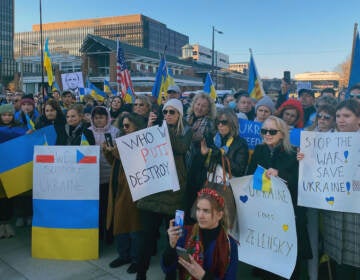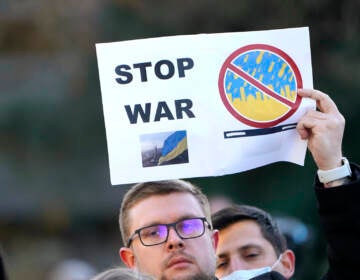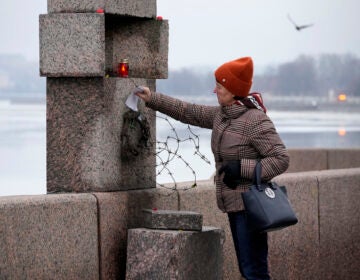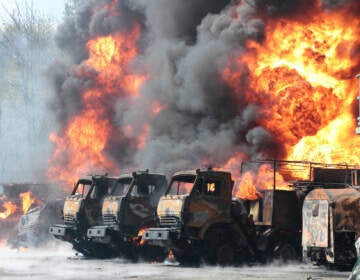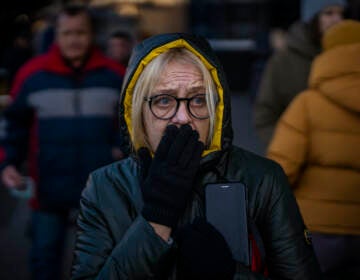Russians besiege crucial Ukrainian energy hub and seacoast
Ukrainian leaders, meanwhile, are calling on citizens to rise up and wage guerrilla war against the invaders.
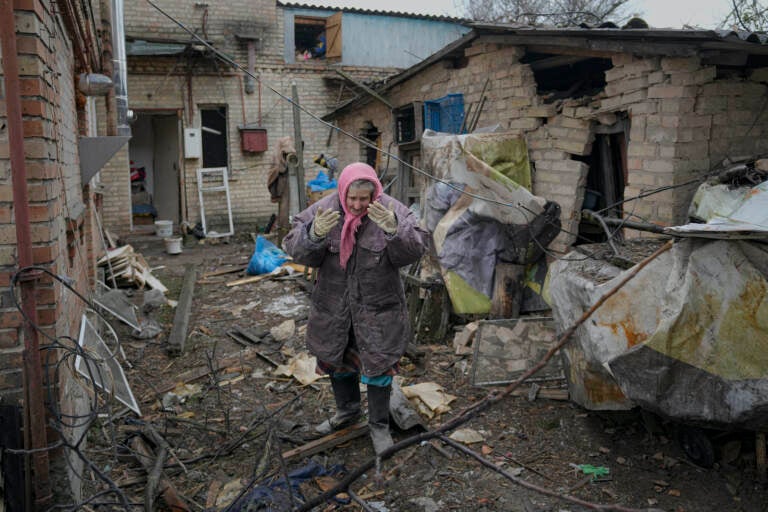
A woman is overwhelmed by emotion in the backyard of a house damaged by a Russian airstrike, according to locals, in Gorenka, outside the capital Kyiv, Ukraine, Wednesday, March 2, 2022. (AP Photo/Vadim Ghirda)
Russian forces battled for control of a crucial energy-producing city in Ukraine’s south on Thursday and gained ground in their bid to cut off the country from the sea, as Ukrainian leaders called on citizens to rise up and wage guerrilla war against the invaders.
The fighting at Enerhodar, a city on the Dnieper River that accounts for about one-quarter of the country’s power generation, came as another round of talks between the two sides yielded a tentative agreement to set up safe corridors inside Ukraine to evacuate citizens and deliver humanitarian aid.
The mayor of Enerhodar, the site of the biggest nuclear plant in Europe, said Ukrainian forces were battling Russian troops on the city’s outskirts. Video showed flames and clouds of black smoke rising above the city of over 50,000, with people streaming away from the inferno, past wrecked cars, as sirens wailed.
Moscow’s ground advance on Ukraine’s capital in the north has apparently stalled, with a huge armored column at a standstill outside Kyiv. And stiffer-than-expected resistance from the outmanned, outgunned Ukrainians has staved off the swift victory that Russia may have expected.
A top Russian officer, Maj. Gen. Andrei Sukhovetsky, commander of an airborne division, was killed in the fighting earlier this week, an officers organization in Russia reported.
But the Russians have brought their superior firepower to bear in the past few days, launching hundreds of missiles and artillery attacks on cities and other sites around the country and making significant gains on the ground in the south as part of an effort to sever Ukraine’s connection to the Black and Azov seas.
Cutting its access to the coastline would deal a crippling blow to its economy and allow Russia to build a land corridor to Crimea, seized by Moscow in 2014.
A senior U.S. defense official, speaking on condition of anonymity to discuss military matters, said Russia’s seizure of Crimea gave it a logistical advantage in that part of the country, with shorter supply lines that smoothed the offensive there.
The Russians announced the capture of the southern city of Kherson, and local Ukrainian officials confirmed that forces have taken over local government headquarters in the vital Black Sea port of 280,000, making it the first major city to fall since the invasion began a week ago.
Heavy fighting continued on the outskirts of another strategic port, Mariupol, on the Azov Sea, plunging it into darkness, knocking out most phone service and raising the prospect of food and water shortages. Without phone connections, medics did not know where to take the wounded.
The second round of talks between Ukrainian and Russian delegations was held in neighboring Belarus. But the two sides had little common ground going into the meeting, and Russian President Vladimir Putin warned Ukraine that it must quickly accept the Kremlin’s demand for its “demilitarization” and declare itself neutral, renouncing its bid to join NATO.

Putin told French President Emmanuel Macron he was determined to press on with his attack “until the end,” according to Macron’s office.
After the latest talks ended, both delegations said that they had tentatively agreed to allow cease-fires in areas designated safe corridors, and that the two sides would seek to work out the details quickly. Ukrainian presidential adviser Mykhailo Podolyak said a third round of talks would also be held early next week.
Despite a profusion of evidence of civilian casualties and destruction of property by the Russian military, some of it documented by The Associated Press, Putin decried what he called an “anti-Russian disinformation campaign” and insisted that Moscow uses “only precision weapons to exclusively destroy military infrastructure.”
Putin claimed that the Russian military had already offered safe corridors for civilians to flee but asserted without evidence that Ukrainian “neo-Nazis” were preventing people from leaving and were using them as human shields.
He also hailed Russian soldiers as heroes in a video call with U.N. Security Council members, and ordered additional payments to families of men killed or wounded.
The fighting has sent more than 1 million people fleeing Ukraine, by the U.N.’s count. Ukrainians still in the country faced another grim day. In Kyiv, snow gave way to a cold, gray drizzle, as long lines formed outside the few pharmacies and bakeries that remain open.
More shelling was reported in the northern city of Chernihiv, where emergency officials said at least 33 civilians had been killed and 18 wounded in a Russian bombardment of a residential area. The search for more victims in the rubble was suspended because of renewed shelling.
Families with children fled via muddy and snowy roads in the eastern region of Donetsk, while military strikes on the village of Yakovlivka near the eastern city of Kharkiv destroyed 30 homes, leaving three people dead and seven wounded, according to emergency authorities.
Ukrainian authorities called on the people to defend their homeland by cutting down trees, erecting barricades in the cities and attacking enemy columns from the rear. In recent days, authorities have issued weapons to civilians and taught them how to make Molotov cocktails.
“Total resistance. … This is our Ukrainian trump card and this is what we can do best in the world,” Ukrainian presidential aide Oleksiy Arestovich said in a video message, recalling guerrilla actions in Nazi-occupied Ukraine during World War II.
In a video address to the nation, Zelenskyy praised his country’s resistance.
The Russians “will have no peace here. They will have no food,” he said. “They will have not one quiet moment.”
The mass evacuation could be seen in Kharkiv, Ukraine’s second-largest city, with about 1.4 million people. Residents desperate to escape falling shells and bombs crowded the railroad station and squeezed onto trains, not always knowing where they were headed.
At least 227 civilians have been killed and 525 wounded, according to the office of the U.N. High Commissioner for Human Rights, though it acknowledged that is a vast undercount, and Ukraine said more than 2,000 civilians have died. The figures could not be independently verified.
Meanwhile, the U.S. defense official said the immense Russian column of hundreds of tanks and other vehicles still appeared to be stalled roughly 25 kilometers (16 miles) from Kyiv and had made no real progress in days.
The convoy, which earlier in the week had seemed poised to launch an assault on the capital, has been plagued with fuel and food shortages, the official said.
Russia has fired more than 480 missiles in the invasion, according to the U.S. defense official. Ukrainian officials said their missile-defense systems have parried numerous attacks, though some missiles have clearly made it through. Kyiv Mayor Vitali Klitschko said explosions heard overnight in the capital were Russian missiles being shot down.
From Kherson, Russian troops appeared to roll toward Mykolaiv, another major Black Sea port and shipbuilding center to the west. The regional governor, Vitaliy Kim, said big convoys of Russian troops were advancing on the city.
A group of Russian amphibious landing vessels also headed toward the port of Odesa, farther west, the Ukrainian military said.
Russia reported its military casualties Wednesday for the first time in the war, saying nearly 500 of its troops have been killed and almost 1,600 wounded. Ukraine insisted Russia’s losses are many times higher but did not disclose its own military casualties.
WHYY is your source for fact-based, in-depth journalism and information. As a nonprofit organization, we rely on financial support from readers like you. Please give today.


